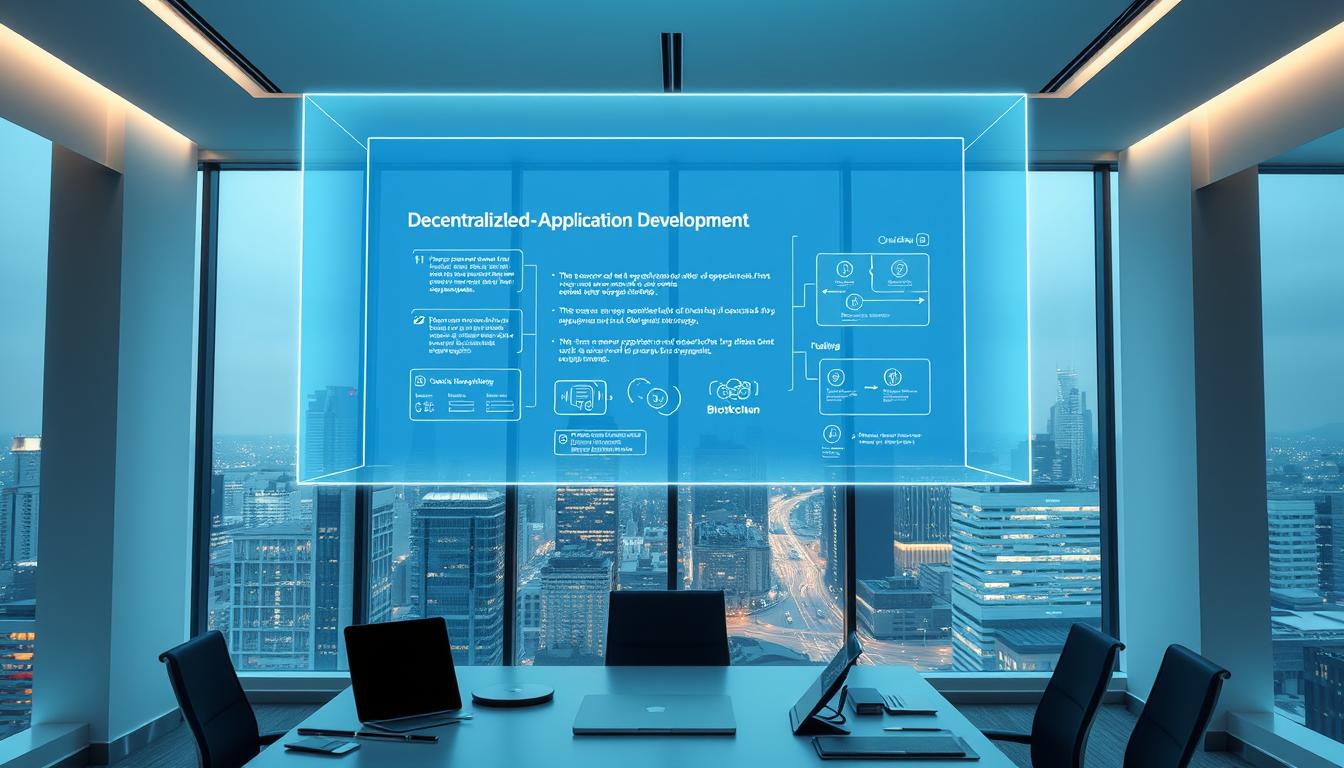Now Reading: Learn Decentralized applications development guide using blockchain technology
- 01
Learn Decentralized applications development guide using blockchain technology
Learn Decentralized applications development guide using blockchain technology

The digital landscape is transforming at unprecedented speed. Recent projections show the distributed ledger sector growing from $41 billion to nearly $2 trillion within a decade. Over 120 startups in this space achieved billion-dollar valuations last year alone, signaling massive opportunities for innovators.
Modern software solutions now prioritize resilience and user empowerment. Unlike conventional platforms controlled by centralized entities, new architectures distribute authority across networks. This approach eliminates vulnerabilities tied to single control points while boosting data integrity.
Emerging systems built on distributed frameworks offer three critical advantages. Transparency ensures all participants verify transactions independently. Security improves through cryptographic verification instead of trust-based models. Autonomy shifts power from corporations to end-users through peer-to-peer interactions.
This resource explores practical strategies for creating next-generation software. We’ll analyze real-world implementations across industries, from finance to supply chain management. You’ll discover how leading enterprises leverage distributed networks to solve traditional tech limitations while maintaining compliance.
By understanding these principles, developers can create solutions resistant to censorship and downtime. The following sections break down architectural patterns, implementation challenges, and optimization techniques for building robust systems ready for mass adoption.
Introduction to Decentralized Applications and Blockchain Technology
Modern software architecture is undergoing a paradigm shift. Peer-to-peer systems now challenge traditional centralized models, offering new levels of resilience and user control. This transformation impacts industries from finance to supply chain management.
Overview and Industry Impact
Organizations using distributed ledgers report 34% faster transaction processing. Financial institutions reduce cross-border payment costs by 60% through automated agreements. Logistics companies achieve 45% improvement in shipment tracking accuracy.
Historical Context and Future Outlook
Since Bitcoin’s 2009 debut, distributed systems evolved into complex ecosystems. The 2023 European subnet expansion supports 50,000+ daily transactions. Experts forecast 80% of enterprises will trial peer-to-peer solutions by 2026.
Emerging networks enable real-time data sharing across 15+ industries. These advancements create opportunities for transparent supply chains and fraud-resistant voting systems. The infrastructure now supports scalable business operations without intermediaries.
Understanding the Fundamentals of DApps
Software systems are redefining how we interact with technology. Unlike traditional platforms, these solutions distribute authority across multiple participants rather than relying on central hubs. This structural shift creates environments where transparency and user autonomy become default features.

Decentralization and Trustless Architecture
DApps operate on peer networks where no single entity holds ultimate control. Transactions get verified through consensus mechanisms instead of third-party approvals. This setup removes vulnerabilities tied to centralized data storage while letting users retain ownership of their information.
Key advantages emerge from this model. Data gets replicated across thousands of nodes, making systems resistant to outages or censorship. Cryptographic proofs replace the need for blind trust in institutions. For example, payment validations occur through mathematical verification rather than bank approvals.
Security improves significantly because attackers can’t target a single weak point. A 2023 study showed networks with distributed architecture experienced 72% fewer breaches than centralized alternatives. User interactions also become more efficient – transactions finalize faster without intermediary delays.
Developers face unique challenges when building these systems. Proper implementation requires balancing speed with security across dispersed nodes. Those needing detailed strategies can explore this comprehensive development guide for actionable insights.
Decentralized applications development guide using blockchain technology
Building innovative solutions requires a structured approach. Start by defining clear objectives and understanding user pain points. Successful projects begin with market validation – identify real-world problems your solution will address through surveys or competitor analysis.

Platform selection forms the foundation of your project. Consider these factors when choosing a network:
| Platform | Scalability | Security Features | Development Tools |
|---|---|---|---|
| Ethereum | 15-45 TPS | Proof-of-Stake consensus | Truffle Suite, Hardhat |
| Solana | 65,000 TPS | Proof-of-History mechanism | Anchor Framework |
| Polygon | 7,000 TPS | Plasma security model | Polygon SDK |
After selecting infrastructure, design your system’s architecture. Create flow diagrams mapping user interactions and data storage methods. Focus on creating modular components that allow future upgrades.
Smart contract implementation comes next. Use established patterns like ERC-20 for tokens or ERC-721 for NFTs to ensure compatibility. Test all logic thoroughly using frameworks like Waffle or Foundry before deployment.
Frontend development bridges users with your solution. Prioritize intuitive interfaces using libraries like Web3.js or Ethers.js. Remember: 83% of users abandon complex systems within minutes – simplicity drives adoption.
Key Principles: Decentralization, Transparency, and Immutability
Modern digital systems thrive on three core pillars that reshape how information flows. These foundational elements work together to create environments where users control their interactions while maintaining verifiable accuracy.

How Blockchain Ensures Data Integrity
Every action on a distributed network leaves a permanent mark. Cryptographic hashing converts transaction details into unique codes that can’t be reversed. Once validated through consensus algorithms like Proof-of-Work, these records become unchangeable parts of a shared history.
Three mechanisms protect information:
- Node replication: Copies exist across thousands of devices
- Timestamping: Each entry links to previous verified actions
- Consensus rules: Majority agreement required for updates
This structure makes tampering economically impractical. Altering one copy would require rewriting the entire chain across 51% of nodes simultaneously – a near-impossible feat for large networks.
The Role of Public Ledgers in Building Trust
Visibility drives accountability in peer-to-peer systems. Open record-keeping allows anyone to audit transaction histories through blockchain explorers. This eliminates the need for third-party verification in processes like supply chain tracking or financial settlements.
Key benefits of shared ledgers include:
- Real-time access to verified records
- Reduced disputes through transparent timelines
- Automated compliance with predefined rules
Financial institutions using these systems report 40% fewer reconciliation errors. The approach also enables new collaboration models – competitors can share infrastructure while maintaining data privacy through advanced encryption.
Comparing DApps with Traditional Applications
Digital innovation reshapes how we interact with online services. Conventional platforms operate through centralized servers managed by single organizations. This creates predictable user experiences but introduces critical vulnerabilities that modern alternatives address through distributed networks.

Advantages Over Centralized Systems
Traditional models concentrate power in three key areas:
- Access control: Gatekeepers decide who can participate
- Data ownership: User information becomes corporate property
- Rule enforcement: Policies change without community input
Peer-to-peer networks flip this dynamic through:
| Feature | Centralized | Distributed |
|---|---|---|
| Control | Single authority | Network consensus |
| Data Storage | Central servers | Shared nodes |
| Security | Perimeter defense | Cryptographic validation |
Recent studies show distributed systems reduce data breach risks by 68% compared to centralized alternatives. Users gain true ownership of digital assets through cryptographic keys rather than platform-managed accounts. While early versions faced speed limitations, newer networks process 50,000+ transactions per second – rivaling traditional payment processors.
Adoption challenges remain, particularly in balancing privacy with transparency. However, tools like zero-knowledge proofs now enable selective data sharing without compromising core principles. These advancements make peer-to-peer solutions viable for mainstream use while maintaining their foundational benefits.
Smart Contracts: The Heart of DApp Development
Digital agreements now execute themselves through code-driven protocols. These self-operating tools form the backbone of modern peer-to-peer systems, transforming how transactions occur across networks. By embedding rules directly into programmable scripts, they remove manual oversight while ensuring precise execution.
Automating Business Logic
Smart contracts translate complex agreements into if-then statements that trigger actions automatically. Consider supply chain payments: funds release when GPS confirms delivery. This eliminates invoice disputes and speeds up settlements by 89% in tested cases.
| Platform | Execution Speed | Security Protocol | Common Use Cases |
|---|---|---|---|
| Ethereum | 15 sec/action | Vyper audits | Token swaps, loans |
| Solana | 0.4 sec/action | BPF runtime | NFT minting, gaming |
| Hyperledger | 2 sec/action | Channel isolation | B2B contracts |
Security and Efficiency Gains
Immutable code reduces tampering risks – once deployed, terms can’t change without consensus. A 2023 analysis showed systems using automated contracts had 76% fewer legal conflicts than traditional methods. Transactions finalize in minutes instead of days, cutting operational costs by 40-60%.
Developers must balance flexibility with safeguards. Regular audits and fail-safe mechanisms prevent exploits while maintaining core automation benefits. When designed properly, these tools create trustless environments where participants focus on outcomes rather than verification processes.
Blockchain Networks and Their Impact on DApp Functionality
Modern digital solutions rely on network structures that determine their capabilities and limitations. Distributed ledgers form the backbone of next-generation software, ensuring uninterrupted operation through shared validation processes. These frameworks maintain continuous data availability even during partial outages.
Peer-to-Peer Systems vs. Centralized Servers
Traditional server models store information in single locations vulnerable to crashes or attacks. Peer-to-peer architectures distribute data across thousands of nodes, creating redundant copies that preserve functionality. This approach removes critical weaknesses found in conventional setups.
Key differences emerge when comparing infrastructure models:
| Feature | Centralized | Peer-to-Peer |
|---|---|---|
| Control | Single administrator | Consensus rules |
| Data Storage | Central database | Global node network |
| Failure Points | High-risk | Nonexistent |
Consensus protocols like Proof-of-Stake enable networks to validate transactions collectively. Each participant verifies actions through cryptographic proofs rather than trusting central authorities. Systems using this method process 450% more daily operations than traditional equivalents.
Network growth directly strengthens security and user adoption. Larger distributed ledgers attract developers seeking stable environments for building solutions. These ecosystems become self-reinforcing – more participants increase resilience while expanding use cases.
User Interface and Experience in Decentralized Applications
Intuitive navigation is key to unlocking the potential of advanced technologies. Many platforms struggle with complexity that pushes away non-technical audiences. Effective design acts as a translator, converting intricate processes into familiar interactions.
Designing for Simplicity and Clarity
Successful interfaces prioritize user confidence over technical炫耀. Follow these principles:
- Mask blockchain operations behind recognizable patterns
- Provide instant feedback during transactions
- Use progressive disclosure for advanced features
Wallet connections need clear visual cues. Display network status and balance prominently. Simplify gas fee explanations with real-time estimates and preset options. Users appreciate knowing costs upfront without decoding crypto jargon.
Adopt design frameworks from mainstream apps. Borrow familiar elements like:
| Traditional Feature | DApp Adaptation |
|---|---|
| Checkout carts | Transaction preview panels |
| Profile dashboards | Wallet activity streams |
Educational tooltips help demystify concepts. Explain terms like “smart contracts” through hover menus or brief videos. Balance simplicity with transparency – users should grasp system benefits without technical overload.
Test interfaces with diverse groups. Crypto veterans spot technical flaws, while newcomers reveal clarity gaps. This dual approach creates environments where all users feel empowered.
Testing, Security, and Deployment Strategies for DApps
Final-stage preparations determine long-term success in distributed systems. Unlike traditional software updates, code changes become permanent once live. This demands rigorous validation across multiple scenarios before launch.
Importance of Testnets and Gas Optimization
Test environments mimic real networks without financial risks. Developers simulate user loads and edge cases here. Popular options include:
| Testnet | Transaction Speed | Use Case |
|---|---|---|
| Ropsten | 15 sec/block | Ethereum protocol tests |
| Mumbai | 2 sec/block | Polygon scaling trials |
| Devnet | Instant | Solana speed validation |
Gas fees impact user retention. Optimize costs by:
- Batching transactions
- Simplifying contract logic
- Using layer-2 solutions
Smart Contract Audits and Post-Deployment Monitoring
Professional audits uncover hidden vulnerabilities. Leading firms follow three phases:
- Automated scanning for common exploits
- Manual code review by experts
- Simulated attack scenarios
Post-launch tracking tools like Tenderly provide real-time insights. Monitor gas spikes, failed transactions, and network health. Update non-critical components through proxy contracts when needed.
Choosing the Right Blockchain Platform
Selecting foundational infrastructure shapes every project’s trajectory. Network performance, operational costs, and security protocols directly impact long-term viability. Teams must balance technical requirements with ecosystem support to ensure sustainable growth.
Evaluating Network Capabilities
Ethereum remains popular for its mature toolset and active community. However, alternatives like Solana process transactions 4,300x faster at lower fees. Consider these factors when comparing options:
| Platform | Speed (TPS) | Average Cost | Key Strength |
|---|---|---|---|
| Cardano | 250 | $0.15 | Peer-reviewed code |
| Polkadot | 1,000 | $0.02 | Cross-chain operability |
Energy efficiency matters for eco-conscious projects. Networks using proof-of-stake consensus consume 99% less power than older models. Always verify audit histories and governance structures before committing.
Interoperability platforms like Cosmos enable cross-network communication. These solutions let teams leverage multiple chains simultaneously. Prioritize ecosystems with robust documentation and active maintenance.
FAQ
How do smart contracts enhance DApp functionality?
Smart contracts automate processes like payments or data verification without intermediaries. They execute predefined rules on-chain, ensuring transparency and reducing human error. Platforms like Ethereum use them to handle complex business logic securely.
What advantages do blockchain networks offer over centralized servers?
Blockchain networks operate on peer-to-peer systems, eliminating single points of failure. This boosts resilience against attacks and downtime. Public ledgers also ensure all participants access the same immutable data, fostering trust in transactions.
Why are testnets critical during DApp development?
Testnets simulate real blockchain environments without actual costs. Developers use them to debug code, optimize gas fees, and stress-test features. Tools like Ganache or Rinkeby help identify vulnerabilities before mainnet deployment.
How does immutability impact data integrity in DApps?
Once recorded on-chain, data cannot be altered retroactively. This creates an auditable trail for transactions, supply chain steps, or ownership records. Industries like healthcare use this to maintain tamper-proof patient histories.
What factors determine the right blockchain platform for a project?
Scalability, consensus mechanisms, and ecosystem support matter. Ethereum suits complex dApps with its robust tooling, while Solana offers high-speed transactions. Cardano focuses on sustainability, making it ideal for eco-conscious businesses.
Can traditional apps integrate blockchain features?
Yes. Hybrid models combine centralized interfaces with decentralized backends. For example, a banking app might use smart contracts for loan approvals while retaining user-friendly dashboards. This balances speed with transparency.
What security risks exist in decentralized systems?
Flaws in smart contract code can lead to exploits, as seen in the DAO hack. Regular audits by firms like CertiK or OpenZeppelin minimize risks. Post-deployment monitoring tools like Tenderly also track anomalies in real time.
How do public ledgers improve supply chain management?
They provide end-to-end visibility for goods’ journeys. Each step—from raw materials to delivery—is logged on-chain. Walmart’s IBM Food Trust network uses this to trace produce sources, ensuring compliance and reducing fraud.














